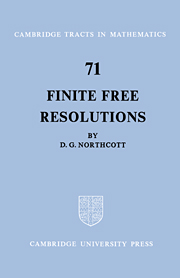Book contents
1 - MATRICES AND DETERMINANTS
Published online by Cambridge University Press: 15 December 2009
Summary
General remarks
Throughout Chapter 1, R will denote a commutative ring with an identity element. Usually the identity element of R will be denoted by 1, but 1R will be used if we wish to draw attention to the ring in which we are working. This chapter is devoted to reviewing certain well known basic facts concerning matrices and determinants and organizing them in a way which will be useful later.
Matrices
By a matrix with entries in R, or an R-matrix, it is customary to understand a rectangular array of elements taken from the ring R. However there are many situations where the order of the rows and the order of the columns is not important. Again, in the theory of vector spaces, a linear mapping of one finite dimensional vector space into another can be described by means of a matrix as soon as each of the two spaces involved has been provided with a base. Now it can happen that one or possibly both of the spaces in question has dimension zero. To deal with such situations we need, for example, the notion of a matrix which has p rows (say) and zero columns. It is because of considerations such as these that we make a fresh start and approach the idea of a matrix from a slightly more general standpoint.
Let M and N be finite sets.
- Type
- Chapter
- Information
- Finite Free Resolutions , pp. 1 - 21Publisher: Cambridge University PressPrint publication year: 1976



